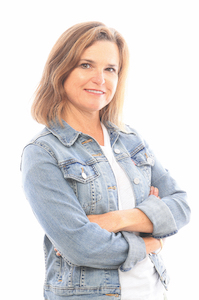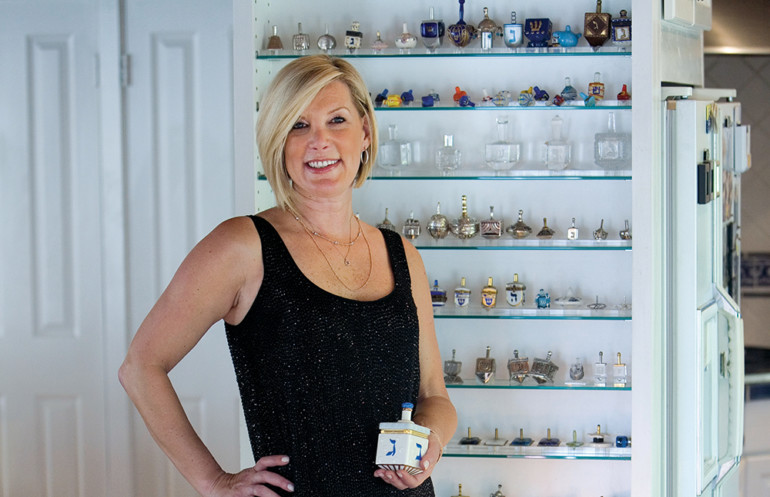
Barbara Ries
Debra Bogaards, partner in the San Francisco law firm Pave & Bogaards who’s often spotted driving around Mill Valley in her convertible with the license plate TRIALSTAR, has a passion. Besides proudly discussing the doings of her two college-age daughters and being in trial, this feisty blond mom loves dreidels. At last count she had 135 of the traditional Hanukkah spinning tops, displayed in a custom-made cabinet in her kitchen.
Could be that these toys take her back to innocent days as little Debbie of Culver City who played handball against her garage door and rode her bike to the beach. Or maybe their Hebrew letters remind her of the three months she spent on a kibbutz in Israel picking pears. At any rate, it started when Bogaards was planning to entertain her daughter’s kindergarten class during the holidays with traditional Jewish dishes like latkes and homemade applesauce. She decided to dazzle her little guests with an assembled medley of dreidels as well. Fast-spin to today, when she lends out her collection and her menorah to a local Starbucks at holiday time. Her thoughts on exploring this fascination here out loud? “I am excited,” she says. “No, thrilled, maybe even a bit ferklempt.”
Are dreidels a bona fide collector’s item? Bonhams & Butterfields may not list any “dreidel transactions” of late, but a quick look on eBay does show a Jerusalem artist’s spinner hand-carved from olive wood ($2,300) and a late 19th-century pewter model from Eastern Europe ($750), plus dozens of options for $50 or less. The Contemporary Jewish Museum Store in San Francisco carries a wide variety in assorted materials—wood, acrylic, dichroic glass, crystal, anodized aluminum—for anywhere from 50 cents to 200 bucks. “When shopping for dreidels, I look for interesting, contemporary takes on this ancient Judaic object,” store director Kevin Grenon says. “I’m attracted to bold colors, whimsical designs and humor.”
The collector reflects
At what point did you realize you were a collector? When I had to get special shelves made and holes drilled into a strip of plastic to showcase my growing number of dreidels. Or, when a friend gave me what I thought was the most hideous dreidel ever, and I put it with the other dreidels on the special shelf, and others admired it, (and) I realized that collecting dreidels meant accumulating a variety of dreidels that everyone could enjoy.
When you think “dreidels,” what comes to mind? Being a small child in my family’s home, and sitting on the floor in a circle with my brothers, spinning a large blue plastic dreidel with gold painted letters. We each put two hazelnuts into the “pot” in the center and then started to play. When my dreidel fell onto the (Hebrew letter) gimmel, I would take all of the nuts in the pot and feel very happy. The smell of simmering latkes would mean our game was over and we were ready for a Hanukkah feast.
What’s the meaning of the Hebrew letter on each side? They are the first letters of four words: nes (the letter nun), gadol (gimmel), hayah (hey) and sham (shin). Translated into English: A great miracle happened there. This refers to what happened after the Maccabees fought the Syrians. The Maccabees found that the ner tamid, or everlasting light, in the synagogue had only one drop of oil left, yet it burned for eight days. . . hence, a miracle! Of course, for the outnumbered Maccabees to successfully defend themselves against the Syrians is really the miracle. I also have some dreidels from Israel, so the fourth letter is different. The letter is pey, which stands for po, which simply means “here.” A great miracle happened here. I also have a very special “mistake” dreidel that my law partner, Bob Pave, found for me. It’s one of my favorites because it’s so unusual!
Can you tell us which one is your most expensive or hardest to acquire? My most expensive are the sterling silver one from Tiffany’s, the stunning glass one from the Skirball museum in L.A. and the mixed sterling silver/14-karat-gold ones from Jerusalem by an Israeli artist. The hardest to acquire are with the “pey” from Israel.
Of course, actually the most expensive probably are the five I bought on a three-hour delay at O’Hare airport. My husband convinced me to grab a taxi and go back to downtown Chicago to the Jewish Museum, which had been closed for Shabbat (Sabbath) the previous day, and buy whatever dreidels I wanted there. I am sure that the round-trip taxi fare was worth it!
Any advice to potential collectors? Select items to add to your collection that you love. For example, I have a handmade beaded dreidel made in New Mexico that is beautiful and unusual. I have many by Limoges, and it’s fun to see each different pattern. I have some that Starbucks, Crate and Barrel, Papyrus and Cost Plus sold, which are very meaningful since it’s hard to find retailers who carry Judaica for Hanukkah. It’s so nice to go into an everyday store and see dreidels rather than being overwhelmed with Christmas ornaments everywhere. So follow your heart.
Expect friends—in my case, my husband and my law partner—to add to your collection, even when you think you are “done” collecting. Your friends may become even more excited than you over your collection; plus, they know what to get you for your birthday! I even had an interviewee for a paralegal position at my law firm bring me back a lovely green Venetian glass dreidel from the oldest ghetto in Italy . . . she got the job!
Do you plan to sell any of them? No. Perhaps I will donate them to a museum or give them to my daughters at some point.
Where are your favorite places to shop for Judaica in the Bay Area? I look online or shop when I travel. In L.A., I love the Skirball museum and Museum of Tolerance gift shops. Here in the Bay Area, sometimes I’m lucky at the Meadowlark Gallery in the Corte Madera Town Center, and in the city; the Glass Pheasant, the JCC and Jewish
Heritage Museum.
Merriam-Webster’s definition of collection: an accumulation of objects gathered for study, comparison or exhibition or as a hobby

Mimi Towle has been the editor of Marin Magazine for over a decade. She lived with her family in Sycamore Park and Strawberry and thoroughly enjoyed raising two daughters in the mayhem of Marin’s youth sports; soccer, swim, volleyball, ballet, hip hop, gymnastics and many many hours spent at Miwok Stables. Her community involvements include volunteering at her daughter’s schools, coaching soccer and volleyball (glorified snack mom), being on the board of both Richardson Bay Audubon Center. Currently residing on a floating home in Sausalito, she enjoys all water activity, including learning how to steer a 6-person canoe for the Tamalpais Outrigger Canoe Club. Born and raised in Hawaii, her fondness for the islands has on occasion made its way into the pages of the magazine.


